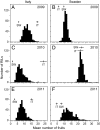Genetic mapping of adaptation reveals fitness tradeoffs in Arabidopsis thaliana
- PMID: 24324156
- PMCID: PMC3876199
- DOI: 10.1073/pnas.1316773110
Genetic mapping of adaptation reveals fitness tradeoffs in Arabidopsis thaliana
Abstract
Organisms inhabiting different environments are often locally adapted, and yet despite a considerable body of theory, the genetic basis of local adaptation is poorly understood. Unanswered questions include the number and effect sizes of adaptive loci, whether locally favored loci reduce fitness elsewhere (i.e., fitness tradeoffs), and whether a lack of genetic variation limits adaptation. To address these questions, we mapped quantitative trait loci (QTL) for total fitness in 398 recombinant inbred lines derived from a cross between locally adapted populations of the highly selfing plant Arabidopsis thaliana from Sweden and Italy and grown for 3 consecutive years at the parental sites (>40,000 plants monitored). We show that local adaptation is controlled by relatively few genomic regions of small to modest effect. A third of the 15 fitness QTL we detected showed evidence of tradeoffs, which contrasts with the minimal evidence for fitness tradeoffs found in previous studies. This difference may reflect the power of our multiyear study to distinguish conditionally neutral QTL from those that reflect fitness tradeoffs. In Sweden, but not in Italy, the local genotype underlying fitness QTL was often maladaptive, suggesting that adaptation there is constrained by a lack of adaptive genetic variation, attributable perhaps to genetic bottlenecks during postglacial colonization of Scandinavia or to recent changes in selection regime caused by climate change. Our results suggest that adaptation to markedly different environments can be achieved through changes in relatively few genomic regions, that fitness tradeoffs are common, and that lack of genetic variation can limit adaptation.
Keywords: QTL mapping; RIL population; divergent selection; genetic drift; inbreeding.
Conflict of interest statement
The authors declare no conflict of interest.
Figures



References
-
- Clausen J, Keck DD, Hiesey WM (1940) Experimental Studies on the Nature of Species. I. Effect of Varied Environment on Western North American Plants (Carnegie Institution of Washington, Washington), Publications No. 520.
-
- Kawecki TJ, Ebert D. Conceptual issues in local adaptation. Ecol Lett. 2004;7(12):1225–1241.
-
- Hereford J. A quantitative survey of local adaptation and fitness trade-offs. Am Nat. 2009;173(5):579–588. - PubMed
-
- Orr HA, Coyne JA. The genetics of adaptation: A reassessment. Am Nat. 1992;140(5):725–742. - PubMed
-
- Barton NH, Keightley PD. Understanding quantitative genetic variation. Nat Rev Genet. 2002;3(1):11–21. - PubMed
Publication types
MeSH terms
LinkOut - more resources
Full Text Sources
Other Literature Sources

